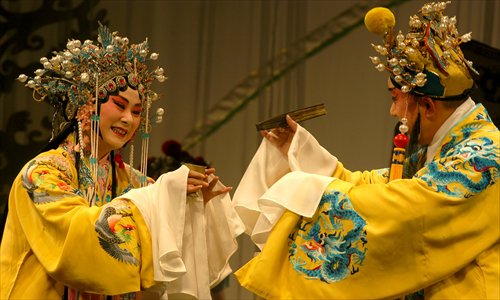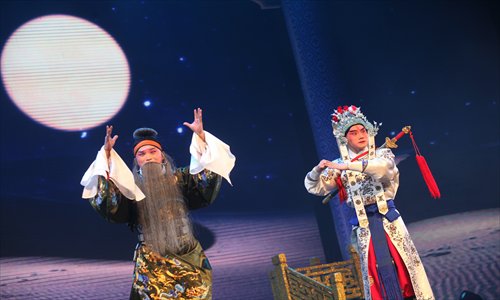Singing for their suppers

A scene from a Kunqu Opera production of The Palace of Eternal Youth Photo: CFP
For more than 400 years Chinese traditional opera has found a home in Shanghai. Sometimes a short-lived home, sometimes a turbulent home but opera has been at the city's cultural heart for a long time. The traditions include Kunqu Opera, the elegant and soft Yueju Opera (a style from Zhejiang Province), and Huju Opera (Shanghai Opera). Peking Opera, the best-known variety of Chinese opera, is also at home here. Chinese opera blends dramatic stories with rarified musical styles, elaborate costumes, dancing, singing, mime and acrobatics.The very first Kunqu Opera performance in Shanghai was recorded in 1578 during the Ming Dynasty (1368-1644), which makes this form one of the oldest of all existing Chinese opera styles. Originally known as Kunshan music, the opera style originated in Kunshan, Jiangsu Province, one of Shanghai's neighboring provinces.
Obsessive emperor
In 1704 in Shanghai during the Qing Dynasty (1644-1911), a production of the legendary Kunqu Opera, The Palace of Eternal Youth, created a huge public stir. The opera, one of the four classic operas of Chinese culture, is set in the Tang Dynasty (618-907) and tells how Emperor Xuanzong spoiled his favorite concubine Yang Yuhuan and paid almost no attention to state affairs. His obsession with the beautiful Yang angered the people and a general rebelled, with his forces eventually taking over the then capital Chang'an.
The emperor fled for Sichuan but his beloved was forced to commit suicide. He returned with an army and defeated the rebels. Then he built an extravagant mausoleum to honor his beloved. In the opera the two are brought together again with the help of a powerful sorcerer and pledge their love again in the Guanghan Palace of the moon.
It is an Kungqu Opera packed with drama and romance but the reality of the opera's first productions were even more dramatic than the work itself. The creator was the writer Hong Sheng (1645-1704). He had spent more than 10 years working on the opera and was a courtier but he made the mistake of watching a performance of his work in 1689 during the official mourning period for the Empress Xiaoyiren. He was thrown into prison for this and soon afterwards left Beijing.
Five years later, however, he was apparently forgiven and was invited by the then governor general of Jiangnan Province, Zhang Yunji, to Shanghai to view a major production of his opera which ran for five acts and 50 scenes. Some of the greatest Kunqu Opera performers appeared in this. Soon afterwards Hong Sheng was invited to Jinling (today's Nanjing) to view the opera once again. He drowned in 1704 falling from a boat after drinking wine.
Kunqu develops
In 1783, the Shanghai Kunqu Opera Troupe was established. Kunqu Opera performances continued to flourish throughout the reigns of Emperor Qianlong and Emperor Jiaqing in the Qing Dynasty. And the art form was maturing, finding appreciation in the court in Beijing.
In 1851, the first dedicated opera house, Sanyayuan, opened in Xiaodongmen county in Shanghai, giving Kunqu Opera an official home. By 1863 the opera form had begun to expand from the city's counties to the foreign settlements. By 1875, more than 100 Kunqu Opera performers from Suzhou and Shanghai could be seen at work in the city.
Kunqu Opera would have been flourishing at that time but for the fact that performers from Huizhou, Anhui Province and Beijing were in town, bringing different opera styles to the people. By 1876 audiences at Sanyayuan had dropped to 60 percent. It struggled to survive, moving several times and even shutting down occasionally but it persisted in only performing Kunqu Opera. However, in 1890, Sanyayuan ended its reign. In the late 19th century, Kunqu Opera troupes could only find occasional work by merging with other opera companies.
It was a long time before Kunqu was revived. In 1985, the State authorities announced plans to revitalize the art form and a commission dedicated to this began work in Shanghai the following year. The commission actually rescued Kunqu Opera from oblivion, restoring a lot of the repertoire and performers and training new stars. After China implemented the reform and opening-up policy, Kunqu Opera troupes toured abroad to Italy, Japan, the US, the UK, France and other countries, bringing the ancient art form to new admirers.
In 2001 UNESCO proclaimed Kunqu Opera an Intangible Cultural Heritage of Humanity. Today in the city many of the classical opera are performed regularly and fans still enjoy The Peony Pavilion and The Peach Blossom Fan in almost the same way fans regarded the operas 400 years ago.

Peking Opera actors perform to commemorate Zhou Xinfang, the legendary master of the art form. Photo: CFP
A Shanghai touchPeking Opera has always been regarded as the essence of Chinese culture, presenting dramatic and intriguing stories with historical references, exquisite costumes, graceful gestures and dazzling martial arts. But despite its name, it is inextricably linked with Shanghai.
Peking Opera is generally thought to have originated in the 1790s with its musical styles adapted from the Xipi music of Anhui Province and the Erhuang music of Hubei Province. Techniques from many other opera styles were later incorporated into Peking Opera.
In Shanghai, Peking Opera appeared in the 1860s when it was known as Pihuang (a combination of Xipi and Erhuang). In 1876, The Shun Pao (The Shanghai News) referred to the art form as Peking Opera. From then on, the nomenclature spread across the nation and became the official name.
The historical record Days in Tongguang Peking Opera House reported, "For thousands of miles along the Yangtze River, from Wuhan to Suzhou and Hangzhou, as far as Fujian and Guangdong and even Hunan, there are traces of Peking Opera troupes. But their base is still in Shanghai." Back then, many of the famous Peking Opera stars like Tan Xinpei, Sun Caizhu and Wang Guifen, came to Shanghai to appear in productions. Some of them settled down in the city.
To hold a share in the opera market, performers who only sang Huizhou Opera, Bangzi Opera or Kunqu Opera styles began to appear in Peking Opera. The performers, especially the stars from other styles, brought their artistic skills to Peking Opera developing a Shanghai-style of Peking Opera, which emphasized innovation and catered to modern tastes. Traditional Peking Opera is renowned for its conventions and for preserving its forms.
The innovations in Shanghai spread off stage as well. Peking Opera troupes adopted modern management practices, introducing shareholding and giving the stars a say in the day-to-day running of the companies.
An exclusive air
During the reign of Emperor Guangxu from 1875 to 1908, Peking Opera was the only thriving opera style in Shanghai. In the early 20th century, there were nearly 20 teahouses in the city where the staging of Peking Opera was the primary business. In 1913 and 1914, the legendary Peking Opera master Mei Lanfang visited Shanghai to perform.
In the late 1930s, the Shanghai-style of Peking Opera was governed by stars like Zhou Xinfang and Zhang Yingjie. There were thousands of fans, and schools and training centers were opened to coach newcomers in the art form. In the late 1930s, the Shanghai Theater School opened and went on to produce opera stars like Gu Zhengqiu, Guan Zhengming and Zhang Zhengjuan.
During the War of Resistance against Japanese Aggression (1937-45), the city's Peking Opera stars continued to perform in the belief their work would encourage the people that their country would be returned to them.
Financial pressures shut the Shanghai Theater School in 1946 and in May that year, entertainment taxes increased to 60 percent. The Peking Opera stars in the six theaters then still open resigned in protest.
During the Cultural Revolution (1966-76), Peking Opera was forbidden and stars like Zhou Xinfang, were publicly criticized, and some were even persecuted. Most were sent to factories or farms to work.
After the revolution, the cultural heart of the city began to be restored and today stars from the Shanghai Jingju Company (the Shanghai Peking Opera Troupe) perform at the theater in Yueyang Road, Xuhui district and promote the art form in the city's schools.

Yueju Opera performers appear in The Butterfly Lovers. Photo: CFP
Folksongs and farmers
The delicate melodies and gracefulness of Yueju Opera today belie its origins. Yueju Opera, which at one stage was known as Shaoxing Opera, grew out of a form of singing and folk music practiced by farmers in Shengxian county, Zhejiang Province. The company of male performers arrived in Shanghai in 1917 for the first performance outside Zhejiang Province. The artists split their lives between performing and farming.
Their performance in Shiliupu was rough-and-ready and failed to attract crowds so the farmers packed up and returned home within a month. Three other troupes tried to make a mark in Shanghai in the following years but all failed.
It was not until 1919 that a troupe managed to find success in Shanghai. This troupe had rehearsed and polished its performances, borrowing elements from Peking Opera and offering audiences a range of new productions. Soon the troupe added professional musicians on stringed instruments as a permanent fixture and Yueju Opera was born.
There was a strictly men only rule for Yueju Opera performers until July 1923 when Wang Jinshui, a businessman from Shengxian county, invited Yueju Opera star Jin Rongshui to open a school to train young girls in the art form. That year, they recruited more than 20 girls under the age of 13. The following January the very young troupe opened for a season in Shanghai but their unsophisticated performances won them little acclaim and the show closed after four days.
But the push to include women performers didn't stop there and in 1929, a second Yueju Opera school for girls opened. Women began to appear on stage in Yueju Opera performances. By 1941, there were 36 female Yueju Opera troupes in Shanghai and almost all of the recognized stars were women. Male performers struggled to find fame in contrast.
In 1937 Yueju Opera stars like Yao Shuijuan began modifying the style of production, making the shows more diversified in subject matter and techniques. In four years, more than 400 new operas were presented using techniques from other opera styles, from the cinema and even
Western productions.
In April 1950, the first State-level Yueju Opera experimental troupe was established in Shanghai. In March 1955, the Shanghai Yueju Opera Troupe was launched, gathering together leading writers, directors, actors, performers, musicians and designers. In the 1950s, 38 Yueju Opera troupes could be found throughout the city. From the 1950s until the early 1960s, the city's Yueju Opera artists created a number of acclaimed classical works including The Butterfly Lovers, Romance of the West Chamber and Dream of the Red Chamber.
During the Cultural Revolution, however, Yueju Opera, like most other opera forms, was banned. All the performers were plucked from the stage and sent to work in farms or factories. The Shanghai Yueju Opera Troupe was restored in 1979 and today, the troupe is still active in the city, presenting new productions and constantly introducing new techniques and styles.